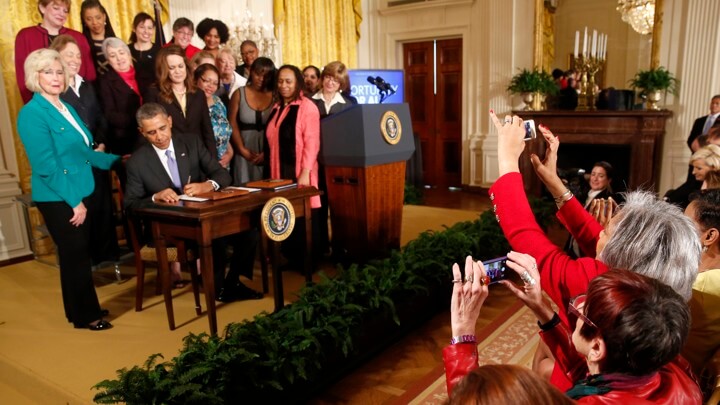
President Barack Obama signs two new executive actions aimed at increasing transparency about women’s pay during an event at the White House in Washington, D.C. on April 8, 2014.
REUTERS/Kevin Lamarque
The Atlantic
January 29, 2016
By Bourree Lam
For Americans who’ve ever wondered whether the person in the next cubicle doing the same job is being paid more, or those who’d like their companies to take a hard look at inequality on the payroll—there’s good news from the government.
On Friday, the Obama administration announced executive action that would require companies with 100 employees or more to report to the federal government how much they pay their employees broken down by race, gender, and ethnicity. The proposed regulation is being jointly published by the U.S. Equal Employment Opportunity Commission and the Department of Labor. It is hoped that this transparency will help to root out discrimination and reduce the gender pay gap—which, according to the White House, leaves women in full-time jobs earning 79 cents for every dollar a man earns. Further, a report from the Council of Economic Advisers found that the gender wage gap in the U.S. is 2.5 percentage points larger than the average among industrialized countries.
The announcement coincides with the anniversary of the Lilly Ledbetter Fair Pay Act, which Obama signed into law in 2009 and allows employees to file lawsuits regarding equal pay for up to 180 days after a discriminatory paycheck. On Friday, Obama will also be calling Congress to pass the Paycheck Fairness Act.
Some criticized the president for attempting to deal with this issue via executive action. Republican Senator Deb Fischer of Nebraska responded that passing a law with bipartisan support is the way forward. “The way to make meaningful, lasting progress on equal pay for women isn’t unilateral presidential action. I remain fully committed to forging a bipartisan consensus in Congress to update our laws and ensure women and men have the information they need to negotiate the salaries they deserve,” said Fischer in a statement. “I urge the president to step up and work with, not around, Congress to make a difference in the lives of working families.”
In a press release regarding the proposed changes, the EEOC argues that “this new data will assist the agency in identifying possible pay discrimination and assist employers in promoting equal pay in their workplaces.” According to the EEOC, this data would point to which industry and occupations have the worst pay disparities. The compensation data would be an addition to employment information companies are already required to submit annually on race and gender—the EEOC says that the aggregate data would be published to help employers “facilitate voluntary compliance.” These requirements would begin in 2017.
“We expect that reporting this data will help employers to evaluate their own pay practices to prevent pay discrimination in their workplaces,” said Secretary of Labor Thomas E. Perez.
Regardless of concerns about race and gender discrimination, talking about compensation at work, though a legal right, is often discouraged by managers and bosses. As concerns rise about lagging wages and pay discrimination, pay transparency has become a popular tactic in recent years, with some companies revealing exactly how they calculate compensation to appease their employees.
And sometimes, just being forced to look at the data actually helps. The New York Times reports that Marc Benioff, the chief executive of Salesforce, was enlisted to support these new rules. Last year, Salesforce reviewed the salaries of all 17,000 employees after two female employees asked Benioff to examine whether the company paid women fairly. Benioff was skeptical of this claim, but commissioned the internal review anyway. The results surprised him, and the company added $3 million to its payroll to address the inequities.

Comments